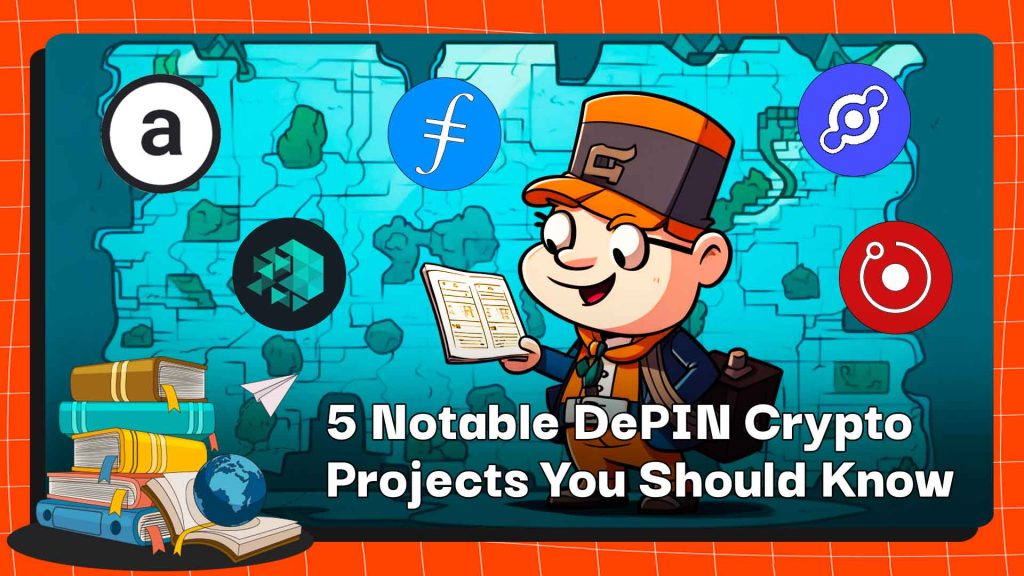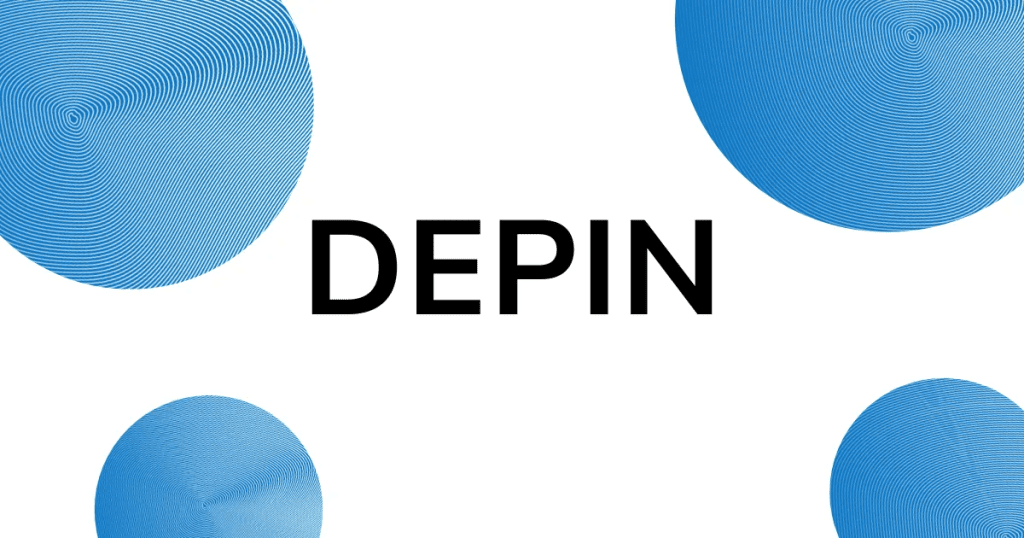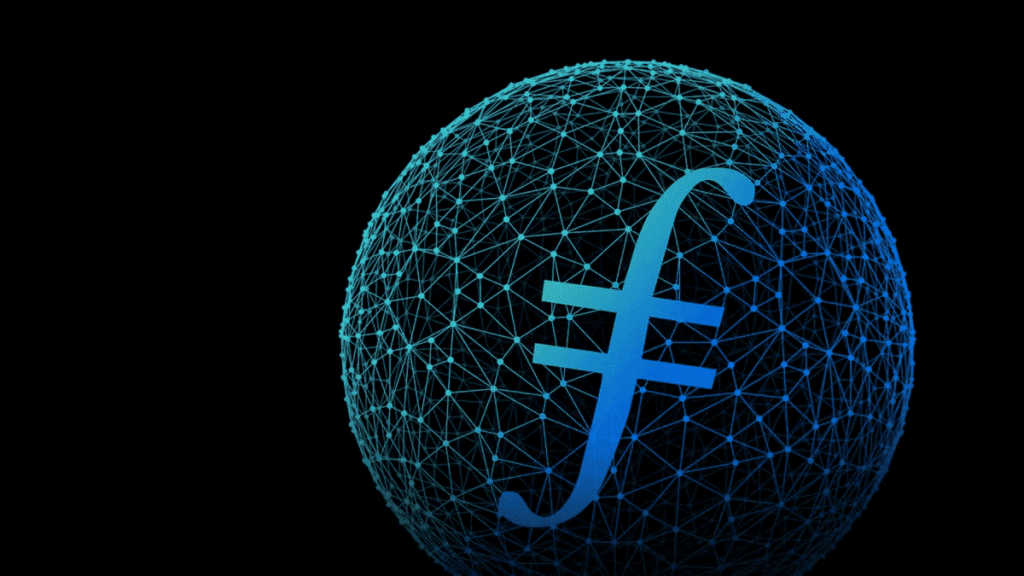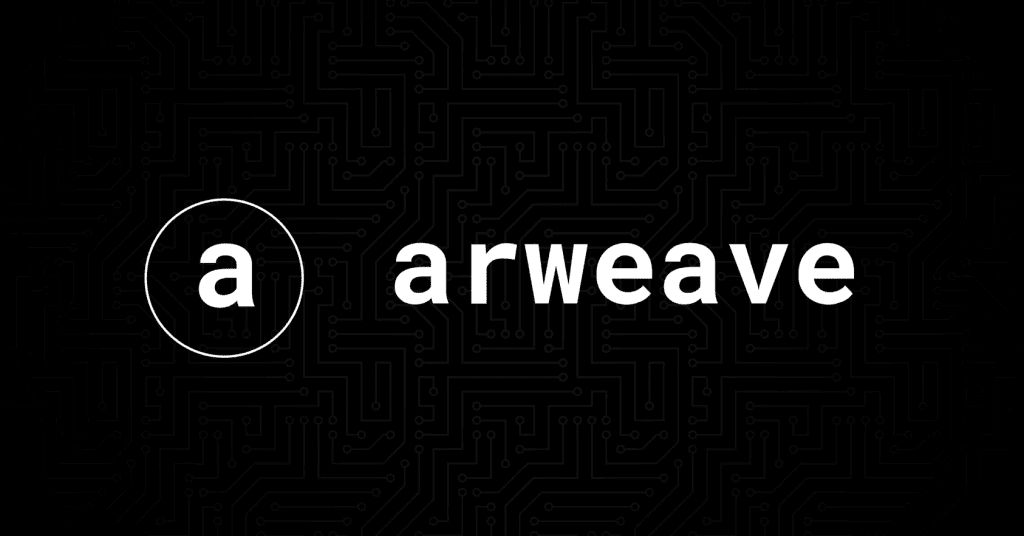DePIN, standing for Decentralized Physical Infrastructure Network, marks a significant leap forward in leveraging blockchain’s potential to reshape traditional systems. Today, let’s explore notable DePIN crypto projects with Coincu.


But first, let’s find out what the DePIN crypto concept is.
Overview of DePIN crypto
What is DePIN?
Translated as “Decentralized Physical Infrastructure Network,” DePIN aims to revolutionize the conventional model of infrastructure development by harnessing the power of blockchain technology and decentralized management through DAO (Decentralized Autonomous Organization).
DePIN seeks to establish a physical infrastructure network system that leverages blockchain technology and various distribution technologies, steering away from the current centralized model.


The core objective is to foster a decentralized environment where multiple participants collaborate to design, construct, operate, and manage physical infrastructure. The incorporation of blockchain and tokens serves as a catalyst for transforming the traditional approach and shifting the ownership paradigm from a singular entity to a collective ownership structure.
Described as the next evolution in the Internet of Things (IoT) and the Web3 ecosystem, DePIN crypto encourages users and businesses to collectively contribute to the development, maintenance, and operation of infrastructure networks. In this decentralized landscape, ownership is distributed among the community, offering a departure from the monopolistic control seen in conventional models.
Read more: SocialFi Landscape Early Of 2024: Potential Opportunity For Early Participants
Key pieces of DePIN
Here are the four pivotal elements that constitute DePIN’s innovative strategy:
DePIN lays the foundation with a sophisticated cloud storage network, functioning as a robust infrastructure platform dedicated to storage. In the realm of Web2, giants like Google Cloud and Amazon Web Service have dominated this space. However, DePIN brings a Web3 perspective with the inclusion of decentralized solutions such as Storj, Filecoin, and Arweave, offering a more distributed and resilient approach to data storage.
The second pillar of DePIN’s vision encompasses cutting-edge wireless technologies, exemplified by the likes of 5G and LoRaWAN. Within the Web3 landscape, one standout project is Helium, revolutionizing wireless communication and connectivity. DePIN recognizes the importance of these technologies in creating a more accessible and efficient decentralized infrastructure.
At the core of DePIN’s decentralized infrastructure are energy networks, tapping into decentralized energy sources to power the various components mentioned above. This approach ensures sustainability and resilience, as the energy generation is distributed across the network, reducing dependence on centralized power grids. DePIN envisions a future where decentralized infrastructure is not only technologically advanced but also environmentally conscious.
The fourth key element in DePIN’s strategy involves the implementation of a sensor network. This entails connecting a myriad of devices equipped with sensors to collect real-world information. This interconnected web of sensors enhances the network’s ability to gather and process data, contributing to more informed decision-making within the decentralized infrastructure.
What problem does DePIN solve?
The widespread adoption of centralized cloud storage services like Google Cloud, Dropbox.com, iCloud, Mega, and OneDrive has reached unprecedented levels. While these platforms offer convenience, a glaring issue persists – the vulnerability of user data when stored centrally. Threats ranging from network attacks to force majeure events like earthquakes and tsunamis expose user data to significant risks.
Addressing this concern, DePIN crypto has entered the scene, drawing parallels with the decentralized finance (DeFi) movement, particularly in its emphasis on decentralization. DePIN recognizes that the key to ensuring the safety, security, and decentralization of user data lies in the decentralization of essential infrastructure components, such as servers, wireless networks, and decentralized sensors.
Top 5 Notable DePIN Crypto Projects
Filecoin
Overview
Filecoin, a decentralized reserve network designed to securely store crucial user information, is revolutionizing the landscape of data storage through its innovative blockchain solution. The platform utilizes incentives to ensure the reliable and durable storage of files over time. Filecoin is one of the DePIN crypto projects achieving great achievements at the present time.
At its core, Filecoin operates as a peer-to-peer network, providing decentralized storage solutions for files on the internet. Unlike traditional centralized storage services, Filecoin introduces economic incentives to ensure the longevity and reliability of stored files. Crucially, the available storage capacity and pricing are not dictated by a single entity; instead, Filecoin fosters open markets that allow anyone to participate in storing and retrieving files.


In the Filecoin ecosystem, users engage with storage miners—computers responsible for both storing files and proving the accuracy of their storage over time. This unique approach allows users to pay for storage, while others can earn by storing files on their devices. The open market principle ensures a dynamic and competitive environment for storage capacity and pricing.
Filecoin (FIL) serves as the native cryptocurrency within the decentralized storage network. Beyond its primary role, FIL extends its utility by offering file storage services for other decentralized platforms. Moreover, Filecoin’s network promotes interoperability, enabling seamless transaction interactions with other blockchain platforms.
Features
Filecoin introduces a robust system for verifying the memory history of stored files. Users can easily confirm the accuracy of file storage even without an internet connection, thanks to built-in processes. The ability to check the Track Record of hosting providers (Miners) ensures transparency, allowing customers to assess if a provider has faced failures or downtime in the past.
One of Filecoin’s key strengths lies in its openness – anyone can join the network without the need for permission. Becoming a Miner merely requires an internet connection and available disk space. This inclusivity fosters a diverse ecosystem of independent storage providers, reducing entry barriers and promoting a thriving network.
Filecoin revolutionizes pricing dynamics by relying on supply and demand to determine storage and retrieval costs. Unlike traditional models dictated by corporate pricing departments, Filecoin’s open market approach ensures competitive prices for reliable hosting services. Miners compete based on factors such as storage capacity, reliability, and speed, rather than resorting to traditional marketing strategies or user lock-in tactics.
Filecoin places a strong emphasis on transparency and collaboration through open-source code. Both the client-side and hosting service provider code are open source, eliminating the need for providers to develop proprietary software for managing their infrastructure. This approach ensures that improvements made to Filecoin’s code benefit the entire community, creating a collaborative environment for ongoing enhancements.
Arweave
Overview
Arweave is a groundbreaking platform that offering users the ability to store data on a decentralized computer network rather than relying on a single centralized server. The platform employs a novel data storage model known as “blockweave,” enabling the permanent storage of data even when the computers storing it are offline. Arweave is also one of the prominent DePIN crypto projects.
Arweave distinguishes itself as a blockchain data storage protocol, utilizing the cutting-edge Proof of Access consensus algorithm to establish the world’s inaugural truly permanent data storage system. The development team’s primary objective is to create a repository that is not only permanent but also cost-effective and moderated.


Notably, Arweave (AR) operates on its own Blockchain Protocol, featuring its native token, AR Token. This dual-layered approach enhances the platform’s functionality, providing a comprehensive ecosystem for users seeking secure, permanent, and cost-efficient data storage solutions.
Features
Arweave introduces Blockweave, a novel concept likened to a chain of interconnected blocks filled with transactions. Unlike traditional blockchain structures, Arweave’s Blockweave allows for the verification of low transactions without necessitating ownership of the entire block chain.
This innovative approach not only streamlines the verification process but also provides a scalable solution for on-chain data storage systems. The result is a reduction in costs and energy consumption, marking a significant advancement in the blockchain space.
At the core of Arweave’s consensus mechanism is Proof of Access (PoA), also known as Miners’ Proof of Access. To participate in the mining process within the network, users are required to present a PoA, incorporating historical data. This unique approach ensures that miners contribute valuable historical information before adding new blocks to the chain. PoA not only enhances the security of the network but also promotes a more inclusive and trustworthy mining environment.
Arweave advocates for the unrestricted mining and sharing of data through its Wildfire feature. The network nodes, structured into a route configuration, enable global distribution in the most efficient manner possible. This fast-acting system encourages users to freely mine and share data, fostering a dynamic and collaborative ecosystem within the Arweave network.
Addressing the inefficiencies of traditional blockchains, Arweave introduces Blockshadows. In contrast to the conventional approach of distributing entire blocks to every network node, Blockshadows streamline the process.
By facilitating faster handling of the hashing process between wallet lists, nodes can instantly share transactions with each other. This innovation ensures that network speed and transaction consensus are not hampered, even during periods of increased network usage density, preventing sudden spikes in costs.
IoTeX
Overview
IoTeX (IOTX) is a trailblazing “blockchain-in-a-blockchain” dedicated to fostering the growth of the Internet of Things (IoT). Its mission is clear: to establish a borderless ecosystem facilitating seamless interactions between humans and machines, characterized by guaranteed trust, free will, and privacy. IoTeX is not only one of the outstanding DePIN crypto projects but also has the potential for a new internet revolution.
The heart of IoTeX’s ambition lies in crafting future individuals, rather than organizations, which will wield complete control over their devices and data. The cornerstone of this vision is the commitment to ban intrusive ads and surveillance, offering users an unprecedented level of privacy and peace of mind. IoTeX aptly terms this vision the “Internet of Trusted Things.”


At its core, IoTeX envisions the Internet of Trusted Things as the inaugural open, secure, and human-centric ecosystem, uniting autonomous devices and users. This refreshing platform reassures users that their data, identity, and privacy remain firmly within their own grasp.
In an era dominated by concerns over data criticism and privacy infringements, IoTeX stands as a beacon, offering users a sanctuary where they can confidently entrust their personal information without fear of compromise.
Features
IoTeX acknowledges the multifaceted requirements of IoT applications, which necessitate diverse features within the blockchain. To avoid bloating the blockchain and ensure swift calculations, IoTeX adopts the strategy of separating tasks into individual sidechains.
This approach allows the creation of specialized sidechains for each function, fostering efficient interaction while maximizing both the blockchain’s efficiency and privacy.
IoTeX prioritizes user privacy and transaction confidentiality through the incorporation of ring signatures. By employing ring signatures, IoTeX conceals transaction recipient addresses with forwardable payment codes, providing a robust privacy layer for users.
IoTeX adheres to the principle of Occam’s Razor, recognizing that different IoT devices have distinct requirements. The platform resolves this challenge by ensuring that each device receives precisely what it needs through dedicated sidechains, simplifying the overall IoT network architecture.
IoT blockchain solutions demand lightweight designs to minimize energy consumption, storage, and computing requirements. IoTeX stands out by enabling its blockchains to run in parallel while maintaining interoperability. This is achieved through a unique design that combines a root blockchain for security and governance with sidechains tailored to the specific needs of IoT devices.
IoTeX’s architecture introduces a root blockchain responsible for providing network security and governance. Simultaneously, the root blockchain manages subchains, connecting IoT devices operating in similar environments with comparable reliability or sharing functional purposes. This architectural flexibility ensures scalability and adaptability in diverse IoT scenarios.
IoTeX excels in facilitating fast, efficient, and cost-effective communication between blockchains. The protocol incorporates block finality, ensuring the immutability of newly created blocks and enhancing the overall security and reliability of cross-chain communication.
Helium
Overview
Helium is a decentralized Peer-to-Peer wireless network built on the blockchain platform. This revolutionary initiative aims to provide a secure and cost-effective solution for IoT devices seeking seamless interaction with the Internet. Helium is among the DePIN crypto projects that are creating many new breakthroughs with great development potential.
Helium’s wireless network leverages the power of blockchain technology to create a decentralized infrastructure, ensuring reliability and efficiency for IoT devices. Unlike traditional centralized networks, this innovative approach allows for improved scalability and reduced operational costs.


Features
At the core of the Helium ecosystem is the Helium Hotspot, an affordable hardware device that serves a dual purpose. Not only does it function as a wireless access point on the Helium Blockchain, but it also acts as a mining tool for HNT tokens, providing users with an opportunity for passive income generation.
Facilitating seamless device management, the Helium Console is a dedicated tool for developers. It enables the registration, authentication, and management of devices within the Helium network. Beyond these functionalities, Helium Console offers flexible connections, allowing device data to be routed via HTTP or MQTT.
Incorporating an innovative mining mechanism, Helium employs radio waves for Proof of Coverage. This method serves to verify the extent of network coverage, ensuring the reliability and efficiency of the Helium ecosystem.
LongFi marks a significant leap forward by combining the LoRaWAN protocol with the Helium blockchain. This integration empowers any LoRaWAN device to seamlessly transmit data within the Helium blockchain. Key features of LongFi include:
- Easy Device Integration: Streamlined device integration without the need for additional configuration or third-party assistance.
- Device Roaming: Devices integrated with LongFi can effortlessly send data within the network via any Helium Hotspot, thanks to unique IDs stored on the blockchain.
- Earn HNT Tokens: Device owners can earn HNT tokens when their devices transmit data over the Helium network.
- LoRaWAN Support: Minimal configuration requirements allow any LoRaWAN device or sensor to transmit data within the Helium network.
Helium Tabs introduces a revolutionary location tracking app connected to the Helium network. This app enables users to track the whereabouts of their possessions, including pets, luggage, keys, and more, within the coverage of the Helium network.
Render Network
Overview
Render Network has unveiled a cutting-edge platform that facilitates the sharing of idle Graphics Processing Units (GPUs) among users. This innovative system allows individuals to harness the power of their idle GPUs for rendering purposes, specifically for products such as 3D effects in movies and graphics.
Upon registering their idle GPUs on the Render Network, users transition into node operators, unlocking the opportunity to earn Render Tokens (RNDR) through rendering work. This process entails providing rendering services, including the creation of 3D effects and graphics, for customers, commonly referred to as Creators. Render Network is one of the DePIN crypto projects that many people choose because of the usefulness it provides.
Features
Participants in Render Network gain access to GPU calculations in a decentralized framework. This novel approach significantly improves work efficiency, capitalizing on the specialized features of GPUs.
In the creative landscape, where numerous subjects collaborate on projects involving 2D and 3D images, Render Network serves as the ideal connectivity network. This encompasses a wide array of content creators, designers, and 3D artists, offering a centralized platform for seamless collaboration and efficient project execution.
Participants in Render Network gain access to GPU calculations in a decentralized framework. This novel approach significantly improves work efficiency, capitalizing on the specialized features of GPUs.
In the creative landscape, where numerous subjects collaborate on projects involving 2D and 3D images, Render Network serves as the ideal connectivity network. This encompasses a wide array of content creators, designers, and 3D artists, offering a centralized platform for seamless collaboration and efficient project execution.
Render Network empowers users to monetize their personal GPU rendering capabilities. By engaging in programmed rendering tasks, participants can provide accelerated processing for a diverse range of programs and purposes.
Acknowledging the multifaceted nature of GPUs, Render Network recognizes their utility beyond image processing. The platform facilitates GPU utilization in various domains, including gaming, video processing, decentralized applications (dApps), medicine, and Augmented Reality/Virtual Reality (AR/VR).
How to profit from DePIN crypto projects?
The DePIN sector emerges as a high-growth and profitable space, offering numerous opportunities for individuals to not only earn rewards but also contribute valuable services to the public. This sector has gained notable traction, with projects like Helium and IoTeX providing substantial support to participants.
One of the standout trends within the DePIN crypto sector is the profitability of mining octop space. This mining activity has proven to be a great way for individuals to grow their stacks and capitalize on the thriving crypto space.


Particularly noteworthy is the rapid payoff within the DePIN crypto sector, with the potential for significant returns in less than a month. This quick turnaround adds to the allure of the sector, making it highly lucrative and attractive for those seeking immediate profits.
A key player in this space is crank token mining, which has outpaced the profitability of helium mining. What sets Crank token mining apart is its compatibility for dual mining on the same device, catering to passive income enthusiasts looking to maximize their earnings.
Conclusion
As DePIN crypto projects continue to evolve, the potential for widespread adoption and influence in the realm of physical infrastructure becomes increasingly evident. The decentralized, collaborative, and cost-effective nature of DePIN sets the stage for it to emerge as a major player in transforming how we conceive, establish, and maintain physical infrastructure on a global scale.
The fusion of blockchain technology and token incentives not only signifies a technological advancement but also represents a paradigm shift in the way societies approach the crucial task of building and sustaining the foundations of their physical environment.
| DISCLAIMER: The information on this website is provided as general market commentary and does not constitute investment advice. We encourage you to do your own research before investing. |
Visited 23 times, 23 visit(s) today
Source: https://coincu.com/242331-5-notable-depin-crypto-projects-you-should-know/